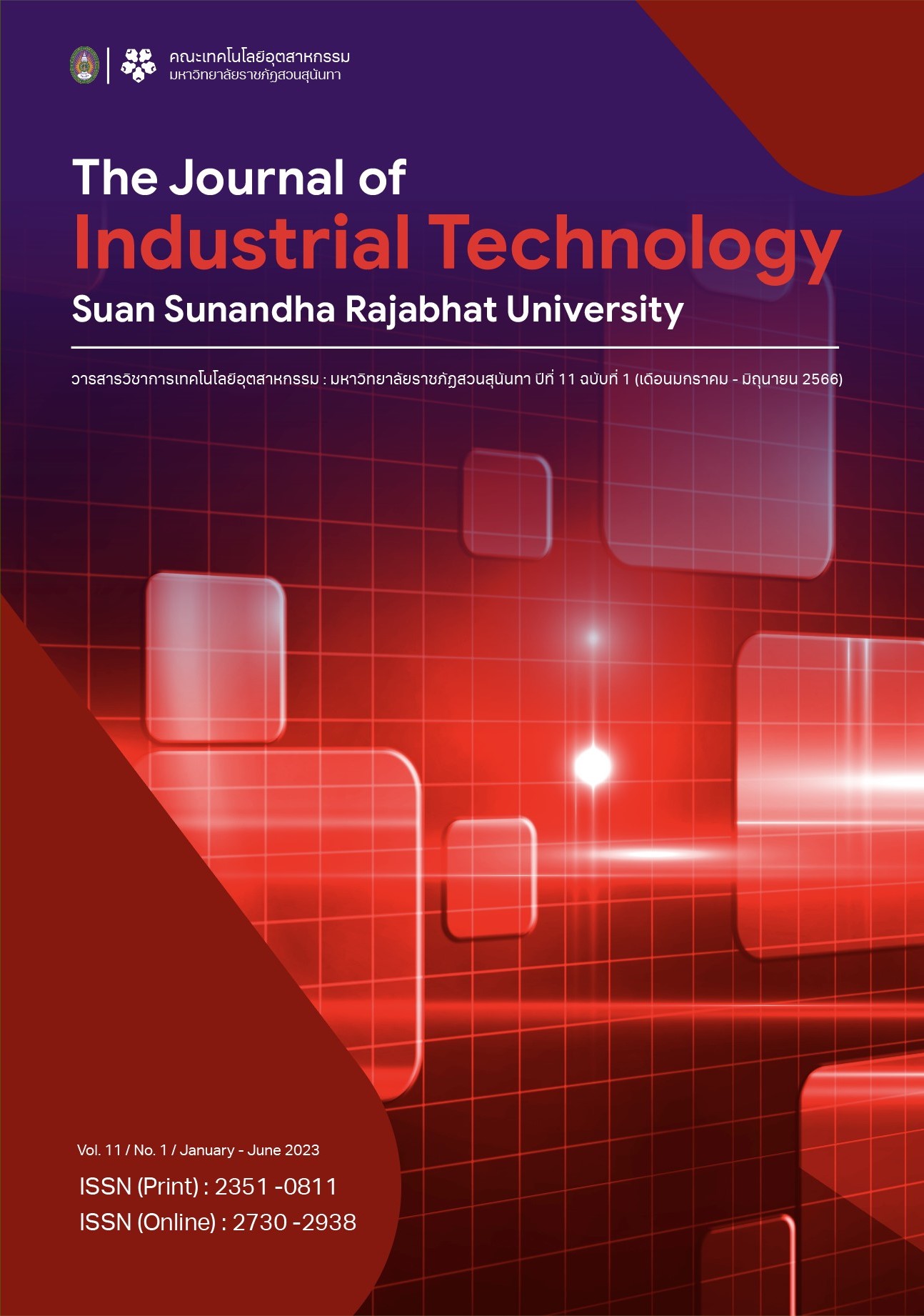ระบบคัดแยกขยะอิเล็กทรอนิกส์
คำสำคัญ:
คัดแยกขยะอิเล็กทรอนิกส์, อินเตอร์เน็ตทุกสพรรสิ่ง, ระบบแยกขยะ, ขยะอิเล็กทรอนิกส์, การเหนี่ยวนำของแม่เหล็กบทคัดย่อ
บทความนี้นำเสนอ ระบบคัดแยกขยะอิเล็กทรอนิกส์ เป็นนวัตกรรมคัดแยกขยะอิเล็กทรอนิกส์ จากขยะทั่วไป เพื่อนำขยะอิเล็กทรอนิกส์ไปจัดการอย่างถูกวิธี ระบบคัดแยกขยะอิเล็กทรอนิกส์ ใช้หลักการเหนี่ยวนำของแม่เหล็ก ในการจำแนกขยะที่เป็นขยะอิเล็กทรอนิกส์ออกจากขยะทั่วไป โดยใช้เชอร์โวมอเตอร์เพื่อหมุนเปิดช่องให้ขยะตกถังที่ถูกต้อง ภายในถังขยะมีการวัดระดับของขยะทั้งสองประเภท นับจำนวนขยะ วัดอุณหภูมิ ซึ่งควบคุมการทำงานด้วยเทคโนโลยีอินเทอร์เน็ตทุกสรรพสิ่งและส่งข้อมูลผ่านระบบ NB-IOT เพื่อจัดเก็บข้อมูลในฐานข้อมูล ระบบแยกขยะอิเล็กทรอนิกส์แสดงข้อมูล ระดับของขยะ จำนวนขยะที่เป็นขยะอิเล็กทรอนิกส์และขยะทั่วไป ตำแหน่งที่ตั้งของถังแยกขยะอิเล็กทรอนิกส์ อุณหภูมิภายใน ผ่านเว็บไซต์แอพพลิเคชั่น สามารถนำมาวิเคราะห์ ออกแบบการจัดเก็บขยะได้อย่างมีประสิทธิภาพ จากการทดสอบนำขยะที่มีลักษณะแตกต่างกัน ทำการทดลอง ทั้งหมด 67 ชิ้น ความแม่นยำ ร้อยละ 89.5 ระบบสามารถตรวจขยะที่มีขนาดกลางขึ้นไป ไม่สามารถตรวจสอบขยะที่มีขนาดเล็ก เช่น หูฟังแบบสมอลทอร์ค ได้เนื่องจากปริมาณโลหะไม่สามารถเกิดการเหนี่ยวนำ จำเป็นต้องใช้วงจรเหนี่ยวนำที่สูงขึ้น
References
Thailand Pollution Report 2018 _Thai.pdf [Online]. [cited 2019 Mar 26]. Available from: ttp://www. pcd.go.th/file/Thailand%20Pollution%20Report%202018_Thai.pdf. 2019.
Kiddee P, Naidu R, Wong MH. “Electronic waste management approaches: An overview.” Waste Management, vol.33, no.5, pp. 1237–50. 2013.
Suchitra Wasanadamrongdee, Panet Manomaiwiboon. “Electronic waste The threat is imminent in the high-tech era”. Naval Medical Journal, vol.41, no.3, pp 65-74. 2014.
Prateep Lertchaiprasert. “Green ICT for electronic waste management”. Journal of Vocational and Technical Education, vol.3, no.6, pp 63–74. 2013.
Ercan M, Malmodin J, Bergmark P. “Life Cycle Assessment of a Smartphone”. [n.p.]: Atlantis Press; 2018.
Chaturvedi A, Strasserl C, Eisingerl F, Raghupath L, Henzler MP. “The carbon footprint of e-waste recycling - Indian scenarios”. [n.p.].
Zhang Y, Liu S, Xie H, Zeng X, Li J. “Current status on leaching precious metals from waste printed circuit boards”. Procedia Environmental Sciences, vol.16, pp 560–8. 2012
Chancerel P, Meskers CEM, Hagelü ken C, Rotter VS. “Assessment of Precious Metal Flows During reprocessing of Waste Electrical and Electronic Equipment”. Journal of Industrial Ecology, vol.13, no.5, pp 791–810. 2009.
Yamazaki S, Nakane H, Tanaka A. “Basic analysis of a metal detector”. IEEE Transactions on Instrumentation and Measurement, vol.51, no.4, pp 810–4. 2002.
Krishna Veni G, Srilakshmi P, Uma B. “Automatic Waste (Metal and Non-Metal) Separation using IR Sensor – IJRTS”. : 2. International Journal for Research in Technological Studies, vol.3, no.5, pp 2348-1439. 2016.
Mapari R, Narkhede S, Navale A, Babrah J. “Automatic Waste Segregator and Monitoring System” [Online] [cited 2019 Apr 8]. Available from: https://www.researchgate.net/publication/317720527_Automatic_Waste_Segregator_and_Monitoring_System. 2019.
Vanessa F, Kees B, Ruediger K. “E-Waste Statistics”. Bonn, Germany: United Nations University; 2018.
Anucha Kaewpoolsuk. “Development of high-sensitivity metal detectors for the food industry”. M.P.A.: Naresuan University, 2013.
Russel MH, Chowdhury MH, Uddin SN, Newaz A, Talukder MM. “Development of Automatic Smart Waste Sorter Machine”. n.p.
Sinha RS, Wei Y, Hwang S. “A survey on LPWA technology: LoRa and NB-IoT A survey on LPWA technology: LoRa and NB-IoT”. ICT Express, vol.3, no.1, pp 14–21. 2017.
N. Sornjapo, "Comparative Study of the Accuracy and Precision of Weather Temperature Sensor for Iot in Different Environment," sripatum Chonuri journal, 2021.
“DHT11, DHT22 and AM2302 Sensors,” Adafruit Learning System. https://learn. adafruit.com/dht/overview (accessed Feb. 05, 2023).
Downloads
เผยแพร่แล้ว
How to Cite
ฉบับ
บท
License
Copyright (c) 2023 คณะเทคโนโลยีอุตสาหกรรม มหาวิทยาลัยราชภัฎสวนสุนันทา

This work is licensed under a Creative Commons Attribution-NonCommercial-NoDerivatives 4.0 International License.
บทความที่ได้รับการตีพิมพ์เป็นลิขสิทธิ์ของคณะวิศวกรรมศาสตร์และเทคโนโลยีอุตสาหกรรม มหาวิทยาลัยราชภัฎสวนสุนันทา
ข้อความที่ปรากฏในบทความแต่ละเรื่องในวารสารวิชาการเล่มนี้เป็นความคิดเห็นส่วนตัวของผู้เขียนแต่ละท่านไม่เกี่ยวข้องกับมหาวิทยาลัยราชภัฎสวนสุนันทา และคณาจารย์ท่านอื่นๆในมหาวิทยาลัยฯ แต่อย่างใด ความรับผิดชอบองค์ประกอบทั้งหมดของบทความแต่ละเรื่องเป็นของผู้เขียนแต่ละท่าน หากมีความผิดพลาดใดๆ ผู้เขียนแต่ละท่านจะรับผิดชอบบทความของตนเองแต่ผู้เดียว







